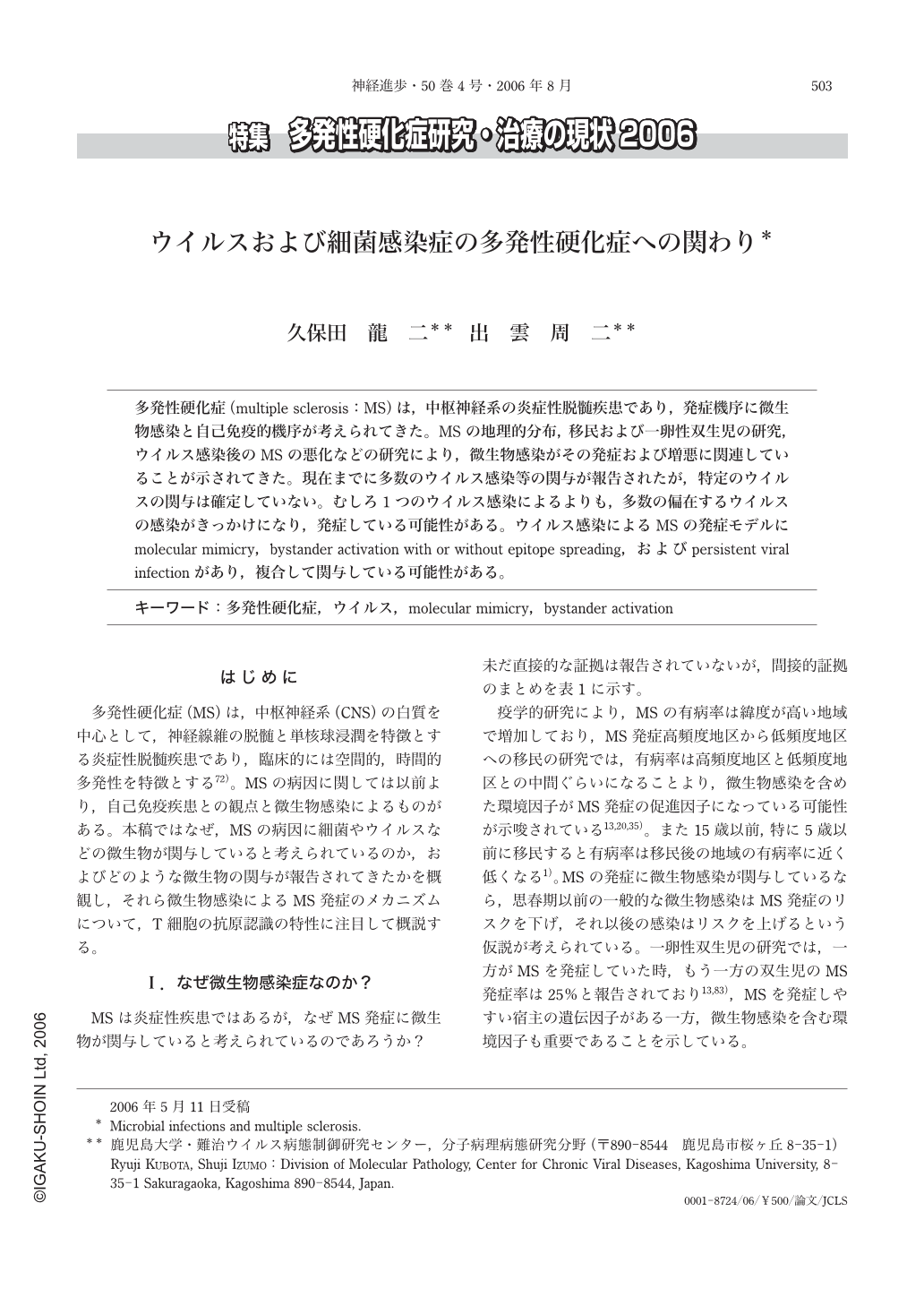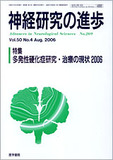Japanese
English
- 有料閲覧
- Abstract 文献概要
- 1ページ目 Look Inside
- 参考文献 Reference
多発性硬化症(multiple sclerosis:MS)は,中枢神経系の炎症性脱髄疾患であり,発症機序に微生物感染と自己免疫的機序が考えられてきた。MSの地理的分布,移民および一卵性双生児の研究,ウイルス感染後のMSの悪化などの研究により,微生物感染がその発症および増悪に関連していることが示されてきた。現在までに多数のウイルス感染等の関与が報告されたが,特定のウイルスの関与は確定していない。むしろ1つのウイルス感染によるよりも,多数の偏在するウイルスの感染がきっかけになり,発症している可能性がある。ウイルス感染によるMSの発症モデルにmolecular mimicry,bystander activation with or without epitope spreading,およびpersistent viral infectionがあり,複合して関与している可能性がある。
Multiple sclerosis(MS)is an inflammatory demyelinating disease of the central nervous system(CNS). It has been postulated that microbial infections or autoimmune process may contribute to the pathogenesis of MS. A large body of evidences from epidemiology including geographical distribution, immigrants, homozygous twins, and preceding viral infections before MS exacerbation, and animal models for virus-induced demyelination indicates that microbial infections are associated with initiation and exacerbation of MS. It has been reported that many viruses such as Epstein-Barr virus, human herpesvirus 6, and measles virus may be associated with the disease, however, despite extensive efforts for seeking a single causative agent for MS, it has not been known. This indicates that multiple microbes, not a single agent, may contribute to the pathogenesis of MS. The possible mechanisms in which viral infections cause the disease include molecular mimicry, bystander activation with or without epitope spreading, and persistent viral infection in the CNS. In the molecular mimicry model, T cells recognize both foreign antigens and self antigens. Peripheral T cells recognize viral antigens after viral infection, some of which migrate into the CNS and cross-recognize autoantigens on antigen-presenting cells(APC)in the CNS, resulting in the tissue damage. Antigen recognition by T cell receptor(TCR)is highly degenerate, in which a single TCR can recognize a huge number of different antigens with various affinities, even if there is no amino acid homology among antigens. Furthermore, T cells originally have a potential to recognize autoantigens, because T cells, which recognize autoantigens with weak affinity, are positively selected in the thymus. Therefore it is not surprising that CNS autoantigen-specific T cells can be detected in the peripheral blood not only from MS patients but also from healthy individuals. These findings strongly support the view that molecular mimicry is considered to be a common phenomenon. However, it is not known whether the mechanism of molecular mimicry is sufficient for the pre-existing autoreactive T cells becoming autoaggressive ones which can induce the disease. In the bystander activation model, which is representative in a demyelinating disease by Theiler’s murine encephalomyelitis virus(TMEV), viral infection to the CNS resident cells causes tissue damage, resulting in epitope spreading of cryptic CNS antigens. CNS APC expressing the released autoantigens sufficiently stimulates the pre-existing autoreactive T cells;thereafter the T cells become autoaggressive to attack the CNS. This model requires some virus to infect the CNS resident cells. The mechanisms of molecular mimicry and bystander activation may not be exclusive for the pathogenesis of MS. In the persistent viral infection model, e. g. TMEV infection, the virus infects CNS resident cells such as oligodendrocytes and destroys the infected cells, resulting in demyelination. HTLV-Ⅰ-associated myelopathy(HAM)is an inflammatory human disease associated with retrovirus infection and resembles the primary progressive form of MS. In HAM, HTLV-Ⅰ-infected CD4+T cells and HTLV-Ⅰ-specific CD8+cytotoxic T cells are increased in the periphery and accumulated in the CNS, causing the immune response to induce the CNS damage. This is bystander activation by non-autoantigen specific, virus specific T cells, which does not need viral infection to the CNS resident cells. So far, it is not known whether autoimmune process can be involved in HAM. It is necessary to do further studies on autoreactive T cells of HAM. The development of immunology will improve our better understanding of MS and will help to establish more effective therapy for the disease.

Copyright © 2006, Igaku-Shoin Ltd. All rights reserved.


